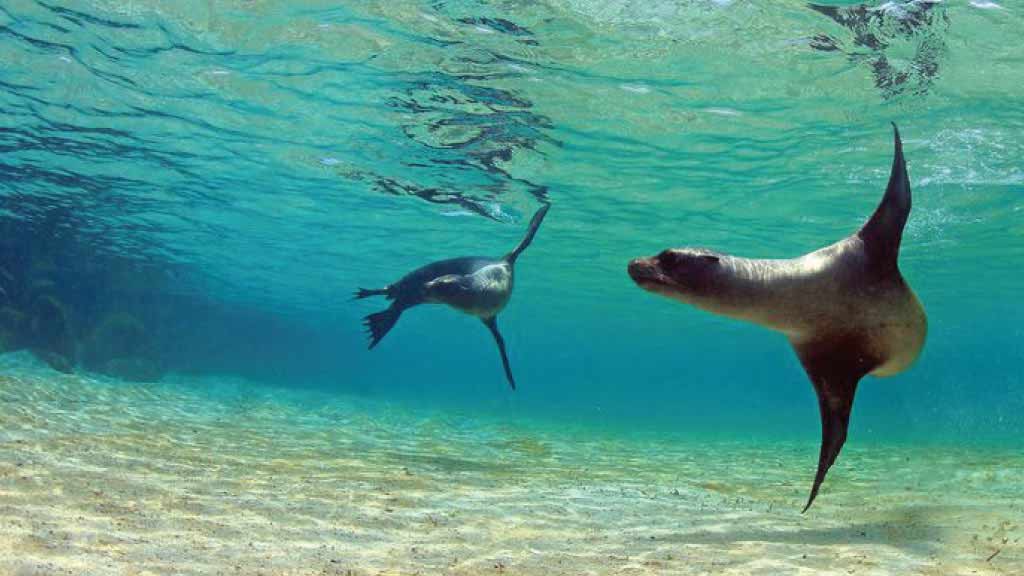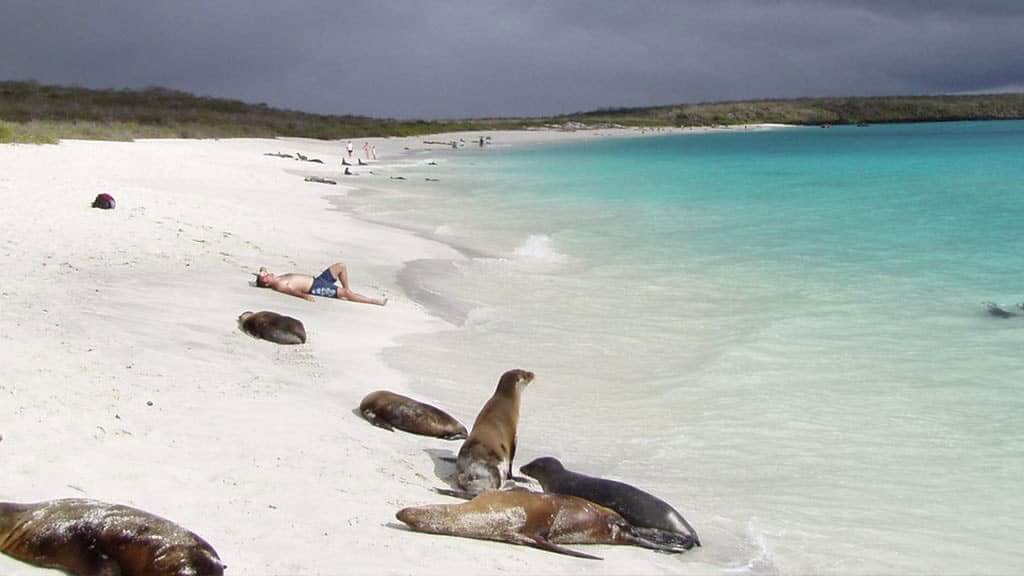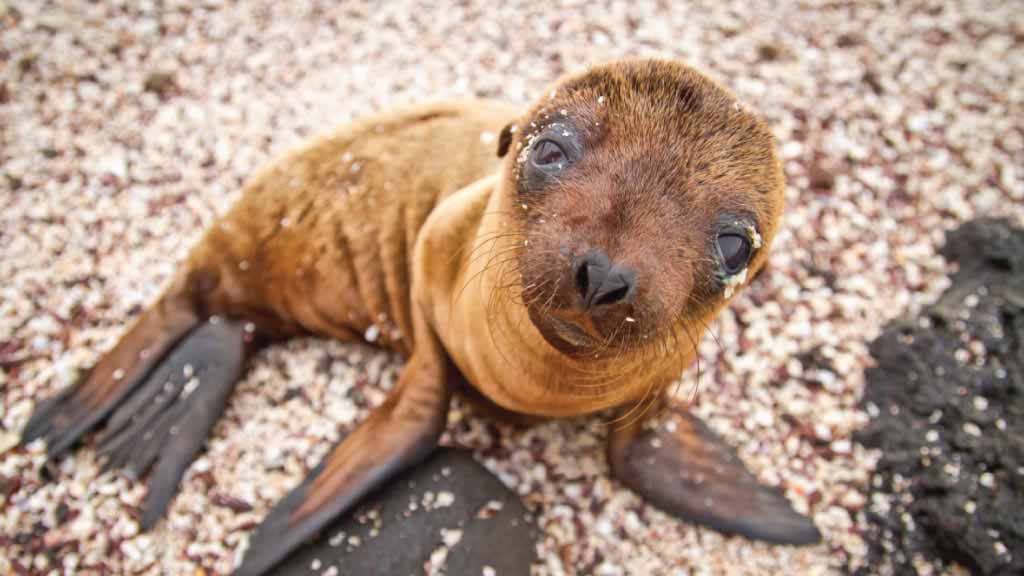GALAPAGOS SEA LION
The Galapagos Sea Lion is one of the stars of the show! Irresistibly cute, especially sea lion pups, they pose for photos in the most amusing places. They are also super friendly and inquisitive, often coming right up to meet tourists face to face. On land, you'll find Galapagos sea lions snoozing the day away or sunbathing. In the sea, they'll swim playful rings around amazed snorkelers. Without a doubt, the Galapagos sea lion will be an unforgettable highlight of your Galapagos experience!
Keep reading to learn more about the playful Galapagos Sea Lion. Where and when to see them? How to recognize them? Plus heaps of other fun Galapagos sea lion facts.
SECURE YOUR GALAPAGOS TRAVEL
Get a FREE personalised quote todayThe Galapagos Sea Lion is an ENDEMIC SPECIES
Conservation Status: Endangered
Scientific Name: Zalophus wollebaeki
How to See a Galapagos Sea Lion?
Galapagos Sea Lions are the most common marine mammal on the islands, with a population size of around 50,000. They are one of the easiest Galapagos species to tick off your list. Visitors will come across them on all or most tour days and at many different sites across the archipelago.
Keep an eye out for Galapagos Islands sea lions swimming in the shallows or sleeping on beaches. They also love to laze around on public benches or docks. Most sea lions are blissfully unaware of the snapping cameras, or at most they might open one sleepy eye out of curiosity.
Visitors don't need to be shy about taking photos or approaching sea lions at Galapagos, but please remember to maintain a minimum distance of 2 meters (6 feet). This is for your own safety as well as the well-being of Galapagos wildlife.
WHERE to see Galapagos sea lions?
Sea lions are literally everywhere in the Galapagos! They are likely to be spotted in the water or on beaches close to the shorelines of most islands. To see large Galapagos sea lion colonies we recommend the following visitor sites: Isla Lobos (San Cristobal), Puerto Villamil Harbor (Isabela), Gardener Bay (Española), South Plaza, North Seymour, Rabida & Bartolome.
WHEN to see sea lions at Galapagos?
Galapagos Sea lions spend their time on the islands all year round. To see cute Galapagos sea lion pups in the nurseries, the best time to visit is between July and November.
Snorkeling with sea lions at Galapagos
Snorkeling with Galapagos sea lions is a great tick for your bucket list and a top Galapagos vacation highlight. Playful sea lions love people. They'll swim right up and around you, doing corkscrew turns, and sometimes coming right up to your mask. Don't be afraid, just enjoy this amazing experience, and take some underwater snaps if you can. Do remember to respect their space, let them come to you and do their thing. Above all, do not touch them.
There are many Galapagos snorkel sites where visitors can share the water with sea lions. Just get your snorkel gear ready, and ask your guide where he/she most recommends during your trip.
Contact us for a FREE GALAPAGOS VACATION QUOTE with no obligations, or for more information to plan your dream Galapagos trip. Either a Galapagos cruise or Land Tour is ideal to spot Galapagos sea lions.
GET FREE ADVICE
From a Galapagos destination expert todayEverything You Ever Wanted To Know About Galapagos Sea Lions
How to recognize a Galapagos Sealion?
In appearance, adult sea lions have brown/grey fur, while newborn pups are more of a chestnut brown color. They have a narrow muzzle and whiskered nose. Their powerful black flippers make them strong and agile swimmers.
Galapagos sea lions are slightly smaller than their Californian cousins. Males (bulls) are big and muscular, weighing 550 pounds on average. Females are up to four times smaller in size than males.
Galapagos Sea Lion Behavior
There are different two types of Galapagos sea lion colonies in the archipelago. Female cows live in a harem colony, controlled by one dominant male bull. All other male sea lions live together in bachelor colonies, consisting of old retired males and young wannabe adolescents.
Galapagos Sea lion mating season runs from May to January each year, although it can vary slightly between different islands. While a dominant male can enjoy breeding with his harem, it is also a stressful time for him. There are many rival male sea lions who would love to take his place and some who are willing to fight him for it. So the alpha male needs to be on constant guard duty, patrolling the waters of his territory. If other bulls do come near he needs to scare them away, or in the worst case fight them. Sea lion fights are very aggressive, with pushing, barging, neck-biting, and dramatic water chases. This is a full-time job, to the extent that the dominant male doesn't even have time to eat. All of his physical exertion results in rapid weight and muscle loss, so he'll likely lose control of his territory after a little more than a week or two.
When sea lion cows give birth a single pup is born. They spend their first week bonding closely with their mom, developing a unique call to distinguish themselves from other pups of the nursery group. The sea lion's mother hunts for food by day, and the pup suckles milk in the evenings. Galapagos sea lion Pups are dependent on their mothers for the first year of their life, although they do also learn to hunt and feed before then.
Galapagos Sea Lion Diet
What does the Galapagos sea lion eat? They love to dine on sardines, squid, and even large tuna fish which they hunt for in packs. Their streamlined bodies make them extremely efficient hunters. They also have an important adaptation that helps them in deep dives. The Galapagos sea lion has evolved a lower metabolic rate than other sea lion species. This gives them the ability to dive to deeper depths and for longer periods of time (up to 10 minutes per dive).
At Galapagos, the hunter also becomes the hunted. The main sealion predators are Orcas and Sharks.
Why is the Galapagos Sea Lion endangered?
The Galapagos sea lion is listed by the IUCN red list as Endangered with decreasing population trend. This is often surprising for visitors who see them in such large numbers right across the archipelago.
The biggest threat to the Galapagos Sea Lion is the El Niño weather phenomenon. El niño occurs every decade or so, affecting the whole coastline of South America. El niño causes a small rise in sea temperatures, which in turn reduces nutrient levels found in the ocean. Fewer algae, plankton, and nutrients mean fewer fish, which also means hungry sea lions. Lack of food disrupts Galapagos sea lion breeding and causes a high infant pup mortality rate. It can take many years for a Galapagos sea lion population to recover after an el niño event.
Human behavior is also a risk to the Galapagos sea lion. Plastic waste in the ocean is easily mistaken for squid and often kills sea lions if ingested. Fortunately, the Galapagos islands are now plastic-free for tourists.
Sea lions can also become caught in fishing nets, as was the case for one Galapagos sea lion named Panchita. Poor Panchita was rescued but suffered severe cuts to her body. She became famous during her recovery, pampered at a luxury Galapagos hotel. In a fittingly happy ending Panchita made a full recovery, and has since given birth to sea lion pups.
There are no active conservation projects underway to specifically protect Galapagos sea lions. But within the Galapagos Marine Reserve, they are a protected species, and their population size is actively monitored.
Fun Galapagos Sea Lion Facts
• Although they may seem lazy, on land a Galapagos Sea Lion can actually run faster than humans, even over rocky terrain. This is possible thanks to their special pelvic girdle which allows them to gallop.
• The Galapagos Sea Lion is an endemic species. Recent DNA testing proves that the Galapagos sea lion is a unique species, separated and evolved from their Californian cousins over 2 million years ago.
• At the archipelago Galapagos Sea lions are often confused with the similar-looking Galapagos Fur Seal. so how can a visitor tell them apart? Firstly, the fur seal's coat is much thicker. Secondly, fur seals have bulgier eyes and more protruding ears. Finally, fur seals tend to be smaller in size, and have broader and shorter heads. The colonies of each species rarely overlap, to avoid competition for food, which can make identification a little easier.
• Even though these amazing creatures are ridiculously cute, and often come right up to visitors, it is really important not to touch them. If humans pass their smell onto a Sea Lion pup then it will likely cause the mother to reject them, which means the pup will perish. Of course, it is also for your own safety – Galapagos sea lions are usually friendly, but they are still wild and unpredictable animals.
Book With The #1 Trusted
Galapagos Travel Agency
If you enjoyed this blog, check out more information about other Galapagos Animal Species.
In conclusion, the Galapagos sea lion is one of the top highlights for many visitors. They are literally everywhere in Galapagos, but few people ever get bored of them. Sea lions are by nature wonderfully social and inquisitive creatures, and love coming up to meet tourists. So by the end of your vacation, you'll have more than enough cute Galapagos sea lion snaps to make Facebook friends green with envy!






